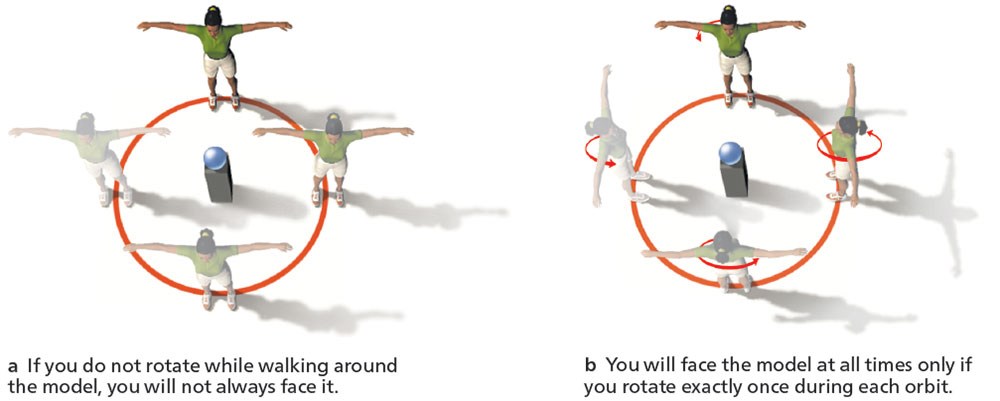Although we see many phases of the Moon, we do not see many faces. From Earth we always see (nearly) the same face of the Moon. This happens because the Moon rotates on its axis in the same amount of time it takes to orbit Earth, a trait called synchronous rotation.
A simple demonstration shows the idea. Place a ball on a table to represent Earth while you represent the Moon (Figure 2.26). The only way you can face the ball at all times is by completing exactly one rotation while you complete one orbit.

Activity
Synchronous Rotation
Before you continue, do the demonstration illustrated in Figure 2.26. Be sure to first make your “orbit” without rotating (as in Figure 2.26a), noticing that you will not always be facing the model Earth you’ve placed on the table. Then walk your orbit while keeping your face toward the model Earth on the table (as in Figure 2.26b). Do you see why keeping your face toward the model Earth (just as the Moon keeps its same face toward the real Earth) means you are rotating exactly once for each orbit?
Teacher Notes. This is a fairly simple activity. The main challenge is making sure that students realize that they are in fact rotating when they keep their face toward the model Earth as they walk around it.
In case you are wondering, the Moon’s synchronous rotation is not a coincidence. It is a consequence of Earth’s gravity affecting the Moon in much the same way the Moon’s gravity causes tides on Earth. We’ll discuss tides in Chapter 4.
Teacher Notes: These questions are generally beyond the scope of what is covered in the NGSS, but they are fun questions that students ought to be able to answer at this point.
To make sure that you understand the Moon’s synchronous rotation, try to answer each question below, discussing with classmates if you wish. Then click to see the answers.
1. About how long would each day and night last if you lived on the Moon?
The Moon is rotating in the same time it orbits, which you already know is about a “moonth” (month). So day and night last about 2 weeks each.
2. The side of the Moon that faces away from Earth is sometimes called the “dark side of the Moon.” Is it actually dark there?
The whole Moon is rotating about once a month, so the whole Moon has roughly 2-week days and 2-week nights. In other words, even on the side of the Moon facing way from Earth, you would have 2 weeks of daylight and 2 weeks of night. Therefore it is better called the “far side” of the Moon.
3. If you lived on the Moon, would you see Earth rise and set in your sky?
No. Because the Moon always keeps the same face toward Earth, you can only see Earth if you live on the side that face Earth, and Earth would always remain in about the same spot in your sky. In other words, assuming you lived on the side of the Moon facing Earth, you would see Earth hanging in your sky as it goes through its phases. If you lived on the far side of the Moon (the side that faces away from Earth), you would never see Earth at all.
4. Why do you think astronomers would like to place radio telescopes on the far side of the Moon?
Radio waves from radio, television, cell phones, and other sources can interfere with astronomical observations made with radio telescopes. The only way to completely eliminate this interference would be to put the radio telescopes in a place where all the radio waves from Earth are blocked – and this would be true on the far side of the Moon.